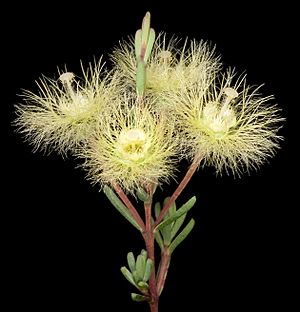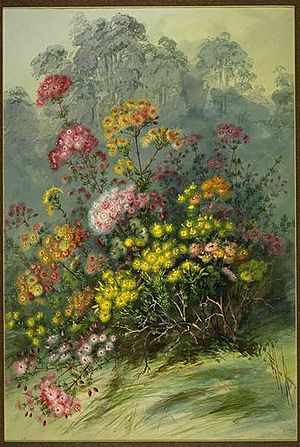Variegated featherflower facts for kids
Quick facts for kids Variegated featherflower |
|
|---|---|
 |
|
 |
|
| V. huegelii, painting by Ellis Rowan | |
| Scientific classification | |
| Genus: |
Verticordia
|
| Species: |
huegelii
|
| Varieties | |
|
V. huegelii Endl. var. huegelii |
|
The Variegated Featherflower (Verticordia huegelii) is a beautiful flowering plant that belongs to the myrtle family, called Myrtaceae. You can only find it growing naturally in the south-west part of Western Australia. This plant is usually a shrub that stands upright, but sometimes it can spread out low to the ground. It has thin, straight leaves and very feathery flowers that bloom in spring. The flowers often start as cream or white. As they get older, they change to pink, red, or even maroon. This color change makes the plant look "variegated," meaning it has many different colors at once!
Contents
What Does the Variegated Featherflower Look Like?
The Variegated Featherflower is a shrub that can grow up to 0.9 m (3 ft) tall. Sometimes, it grows in a sprawling way, spreading out instead of standing tall. Its leaves are thin and shaped like a club. They are also half-round when you look at them from the side. These leaves are usually 2–8 mm (0.08–0.3 in) long.
The flowers of this plant do not have a smell. They grow in round groups near the ends of the branches. Each flower sits on a small stalk that is 4–11 mm (0.2–0.4 in) long. The floral cup (the base of the flower) is shaped like a top and is 2–3 mm (0.08–0.1 in) long. It feels smooth but has some tiny hairs.
The sepals (leaf-like parts that protect the bud) are cream, yellow, or reddish. They are 5–6 mm (0.20–0.24 in) long and have many deep divisions with spreading hairs. The petals are white, cream, or yellow and turn reddish as they age. They are mostly round and spread out, with a fringe of hairs around their edges. These petals are 2–4 mm (0.08–0.2 in) long. The style (part of the female flower) is straight and 5–5.5 mm (0.20–0.22 in) long. It has hairs near the top and a cap-like tip called a stigma. This plant usually blooms from September to November, but the exact time can change depending on the specific type of featherflower.
How the Variegated Featherflower Got Its Name
The Variegated Featherflower was first officially described in 1837 by a scientist named Stephan Endlicher. He wrote about it in a book after Charles von Hügel collected samples of the plant near the Swan River in 1833. The second part of the plant's scientific name, huegelii, is a way to honor Charles von Hügel, who found the first samples. These first samples are called the type specimen.
In 1991, another scientist named Alex George studied the Verticordia plants very closely. He found that the Variegated Featherflower actually has four different types, which are called "varieties":
- Var. huegelii is an upright shrub. Its flowers open as cream, pale yellow, or white.
- Var. decumbens is a shrub that grows very low to the ground, almost flat. Otherwise, it is similar to var. huegelii.
- Var. stylosa is also similar to var. huegelii, but its flowers are greenish-yellow when they first open.
- Var. tridens has different shaped staminodes (parts of the flower that look like stamens but don't produce pollen) compared to the other varieties.
Where the Variegated Featherflower Lives
This featherflower grows in sandy and clay soils. You can often find it near rocks like granite, laterite, or sandstone. It usually grows alongside other types of verticordia plants. Where it grows depends on the specific variety. But generally, you can find it from Geraldton in the north, all the way south to the Porongurup National Park. It also grows inland as far as Wongan Hills. It lives in several different biogeographic regions of Western Australia.
Protecting the Variegated Featherflower
One type of Variegated Featherflower, Verticordia huegelii var. tridens, is listed as "Priority Three". This means that scientists don't know much about it, and it's only found in a few places. However, it is not currently in immediate danger of disappearing. The other three varieties of the Variegated Featherflower are not considered threatened at all.

